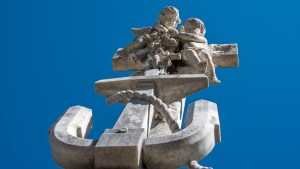Saint Thérèse of Lisieux once wrote in her autobiography, “[T]he symbol of a ship always delights me and helps me to bear the exile of this life. Does not the Wise Man tell us—’Life is like a ship that passeth through the waves: when it is gone by, the trace thereof cannot be found’?”
Ships have been featured in Christian art since the very beginning, appearing first in the catacombs. It was a favorite image of the Church Fathers, who saw the ship as a symbol of the Church.

Read more:
Why are there anchors in Christian art?
The analogy is made clear in the Apostolic Constitutions, a document written in the 4th century.
When you call an assembly of the Church as one that is the commander of a great ship, appoint the assemblies to be made with all possible skill, charging the deacons as mariners to prepare places for the brethren as for passengers, with all due care and decency. And first, let the building be long, with its head to the east, with its vestries on both sides at the east end, and so it will be like a ship. In the middle let the bishop’s throne be placed, and on each side of him let the presbytery sit down; and let the deacons stand near at hand, in close and small girt garments, for they are like the mariners and managers of the ship.
It is no coincidence that the part of every church where the people sit is called a nave. This word comes from the Latin navis, or ship, and was meant to portray the reality that the Church is a ship, protecting those inside it from the waves and buffets of the world.
In early Christian art, Noah’s ark is typically used to represent the Church, while later artists used the episode of Jesus calming the waves at sea.
Furthermore, the Church is often called the “barque of Peter,” with the pope at the helm of the ship, leading it towards the eternal shores of Heaven.
Last of all, ships have been used in art relating to the Blessed Virgin Mary and her title of “Star of the Sea.”
Saint Bonaventure describes this analogy when he wrote, “O poor lost sinners, despair not; raise up your eyes and cast them on this beautiful star; breathe again with confidence, for it will save you from this tempest and will guide you into the port of salvation.”
Ships are a beautiful image, one that has consistently stayed with the Church throughout the centuries.

Read more:
Pope Francis: In moments of darkness choose the path of prayer and hope

